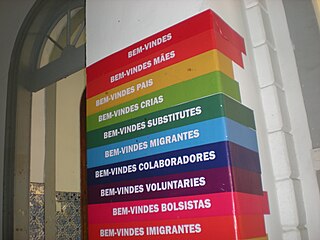Ri (Esperanto pronunciation: [ri] ⓘ , possessive: ria [ˈri.a] ⓘ ) is a singular third-person gender-neutral pronoun [1] in Esperanto intended as an alternative to the gender-specific li ("he") and ŝi ("she"). It is used by some speakers when the gender of a person is not known or when it is not desirable to specify them as either a "he" or "she", similar to how singular they is used in English. In Esperanto, the usage of this pronoun is called riismo ( [ri.ˈis.mo] ⓘ , literally "ri-ism"); it is one of several proposals for gender-neutral pronouns in Esperanto.
On 12 May 2020, Marcos Cramer, a member of the Akademio de Esperanto, published an empirical study on the usage of gender-neutral pronouns in Esperanto. The study concludes by saying that the pronoun ri is now much more widely known and used than ten years ago, and that this development is stronger among young people. It found that the pronoun is very widely used when referring to non-binary people (as well as in the Esperanto Wikipedia), but that the usage of the pronoun to refer to a non-specific person is practiced at a considerable level as well. [2]
The pronoun is not officially endorsed by the Akademio de Esperanto, but some members of the academy use it nevertheless. On 24 June 2020 the advisory body of the academy responded to a question on pronouns for non-binary people: [3]
The question touches on a difficult topic, because in Esperanto there is no traditional pronoun for people who identify as not belonging to one of the traditional genders, and so far no expression has been accepted by the entire language community.
The Akademio de Esperanto carefully observes, analyzes and discusses current language evolution and language debates. As a purely advisory body, but in no way decisive, the Lingva Konsultejo cannot now anticipate a recommendation or other decision or interpretation of the Fundamento that may be made by the Academy. [3]
The pronoun has also been used in lyrics by various musicians, most notably in multiple songs by the band La Perdita Generacio. [4]
The pronoun ri has multiple uses:
The precise history of the pronoun ri is unclear; it appears to have been independently created multiple times, since there were not many other options left that both follow the pattern of other pronouns in Esperanto, and did not yet have another meaning in the language.
The first recorded use of the pronoun was in 1976 in the magazine Eĥo of the Danish Esperanto Association, where it was proposed to be used alongside the already existing pronouns li ("he") and ŝi ("she"). [6] Until about 2010, it remained a seldom used experimental word, but after 2010 its use has increased significantly, especially among younger speakers in Western countries, coinciding with similar shifts towards gender-neutral language in various Western cultures. [7]
The Plena Manlibro de Esperanta Gramatiko, an authoritative and extensive book on Esperanto grammar, used to advise against the use of the pronoun, but as of April 2019 it no longer discourages its use. It now describes without prejudice the various ways in which the pronoun is actually used in practice. [5]
Tial mi proponas enkondukon de la komunseksa pronomo: ri = li aŭ ŝi.[That is why I propose an introduction of the common-gender pronoun: ri = li or ŝi.]

Esperanto is the world's most widely spoken constructed international auxiliary language. Created by L. L. Zamenhof in 1887, it is intended to be a universal second language for international communication, or "the international language". Zamenhof first described the language in Dr. Esperanto's International Language, which he published under the pseudonym Doktoro Esperanto. Early adopters of the language liked the name Esperanto and soon used it to describe his language. The word esperanto translates into English as "one who hopes".
Esperanto is the most widely used constructed language intended for international communication; it was designed with highly regular grammatical rules, and is therefore considered easy to learn.

Ido is a constructed language derived from a reformed version of Esperanto, and similarly designed with the goal of being a universal second language for people of diverse backgrounds. To function as an effective international auxiliary language, Ido was specifically designed to be grammatically, orthographically, and lexicographically regular. It is the most successful of the many Esperanto derivatives, called Esperantidoj.

Novial is an international auxiliary language (IAL) created by Danish linguist Otto Jespersen in 1928. It was designed to facilitate human communication between speakers of different native languages. The name of the language is a blend of the Novial word novi and IAL.

Singular they, along with its inflected or derivative forms, them, their, theirs, and themselves, is a gender-neutral third-person pronoun. It typically occurs with an indeterminate antecedent, to refer to an unknown person, or to refer to every person of some group, in sentences such as:
A third-person pronoun is a pronoun that refers to an entity other than the speaker or listener. Some languages, such as Slavic, with gender-specific pronouns have them as part of a grammatical gender system, a system of agreement where most or all nouns have a value for this grammatical category. A few languages with gender-specific pronouns, such as English, Afrikaans, Defaka, Khmu, Malayalam, Tamil, and Yazgulyam, lack grammatical gender; in such languages, gender usually adheres to "natural gender", which is often based on biological sex. Other languages, including most Austronesian languages, lack gender distinctions in personal pronouns entirely, as well as any system of grammatical gender.
Gender asymmetry is an aspect of the constructed international auxiliary language Esperanto which has been challenged by numerous proposals seeking to regularize both grammatical and lexical gender.
RI or ri may refer to:
The original word base of Esperanto contained around 900 root words and was defined in Unua Libro, published by L. L. Zamenhof in 1887. In 1894, Zamenhof published the first Esperanto dictionary, Universala vortaro, which was written in five languages and supplied a larger set of root words, adding 1740 new words.
An Esperantido is a constructed language derived from Esperanto. Esperantido originally referred to the language which is now known as Ido. The word Esperantido contains the affix (-ido), which means a "child, young or offspring". Hence, Esperantido literally means an 'offspring or descendant of Esperanto'.
Esperanto and Ido are constructed international auxiliary languages, with Ido being an Esperantido derived from Esperanto and Reformed Esperanto. The number of speakers is estimated at 100 thousand to 2 million for Esperanto, whereas Ido is much fewer at 100 to 1 thousand.
Esperanto and Novial are two different constructed international auxiliary languages. Their main difference is that while Esperanto is a schematic language, with an unvarying grammar, Novial is a naturalistic language, whose grammar and vocabulary varies to try to retain a "natural" sound. Demographically, Esperanto has thousands of times more speakers than Novial.
Gender-neutral language or gender-inclusive language is language that avoids reference towards a particular sex or gender. In English, this includes use of nouns that are not gender-specific to refer to roles or professions, formation of phrases in a coequal manner, and discontinuing the collective use of male or female terms. For example, the words policeman and stewardess are gender-specific job titles; the corresponding gender-neutral terms are police officer and flight attendant. Other gender-specific terms, such as actor and actress, may be replaced by the originally male term; for example, actor used regardless of gender. Some terms, such as chairman, that contain the component -man but have traditionally been used to refer to persons regardless of sex are now seen by some as gender-specific. An example of forming phrases in a coequal manner would be using husband and wife instead of man and wife. Examples of discontinuing the collective use of terms in English when referring to those with unknown or indeterminate gender as singular they, and using humans, people, or humankind, instead of man or mankind.

Gender neutrality in languages with grammatical gender is the usage of wording that is balanced in its treatment of the genders in a non-grammatical sense. For example, advocates of gender-neutral language challenge the traditional use of masculine nouns and pronouns when referring to two or more genders or to a person of an unknown gender in most Indo-European and Afro-Asiatic languages. This stance is often inspired by feminist ideas about gender equality. Gender neutrality is also used colloquially when one wishes to be inclusive of people who identify as non-binary genders or as genderless.
Like natural languages, the constructed language Esperanto contains profane words and indecent vocabulary. Some of this was formulated out of the established core vocabulary, or by giving specific profane or indecent senses to regularly formed Esperanto words. Other instances represent informal neologisms that remain technically outside the defined vocabulary of the language, but have become established by usage.
The international auxiliary language Esperanto has been mostly stable since its creation, especially as compared to other constructed languages. This is due to the Declaration of Boulogne in 1905, which made the early works of Zamenhof binding; most attempts to change the language have been therefore seen as distinct language projects, and for the most part the Esperanto community has ignored them. The main change in the language has been a great expansion of the vocabulary, largely driven by translations of technical jargon, which is explicitly allowed for by Boulogne. However, there have been more subtle changes to syntax and semantics as the majority of Esperanto authors shifted from native speakers of Slavic languages and German to other languages, such as French and English. This article considers some of the purposeful changes to the language since Boulogne.
Feminist language reform or feminist language planning refers to the effort, often of political and grassroots movements, to change how language is used to gender people, activities and ideas on an individual and societal level. This initiative has been adopted in countries such as Sweden, Switzerland and Australia.
Elle is a proposed non-normative personal pronoun in Spanish intended as a grammatically ungendered alternative to the third-person gender-specific pronouns él ("he"), ella ("she") and ello ("it"). Elle is intended to be used to refer to people whose gender is not known, not specified, or is neither male nor female. The latter is the most common usage in modern times. This word can be seen as an equivalent of the English singular they.

Gender-neutral language in Portuguese is a recent strand of demands for greater gender equality and social inclusion between men, women and non-binary individuals. It can be divided into inclusive or non-sexist language, and non-binary or neuter language or neolanguage. Inclusive language aims to use existing words to include all genders, while neuter language uses new or modified words to accomplish this.
Iel is a neopronoun in the French language intended as an alternative to the gender-specific pronouns elle ("she") and il ("he"). It has been adopted by the Le Robert dictionary but is not officially accepted by the Académie Française.